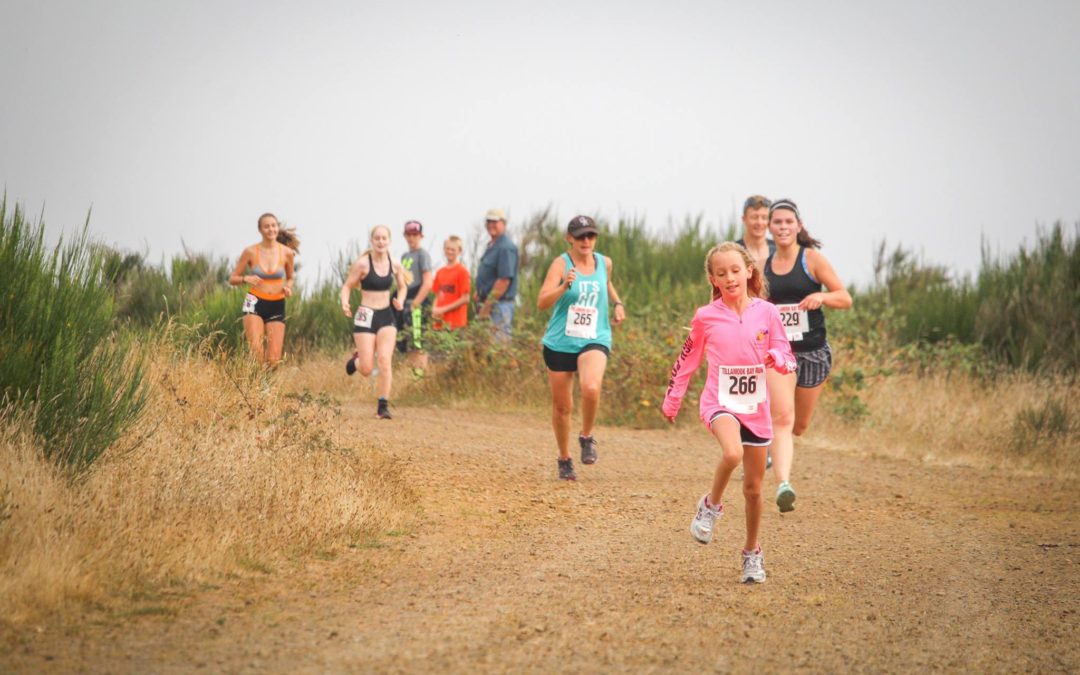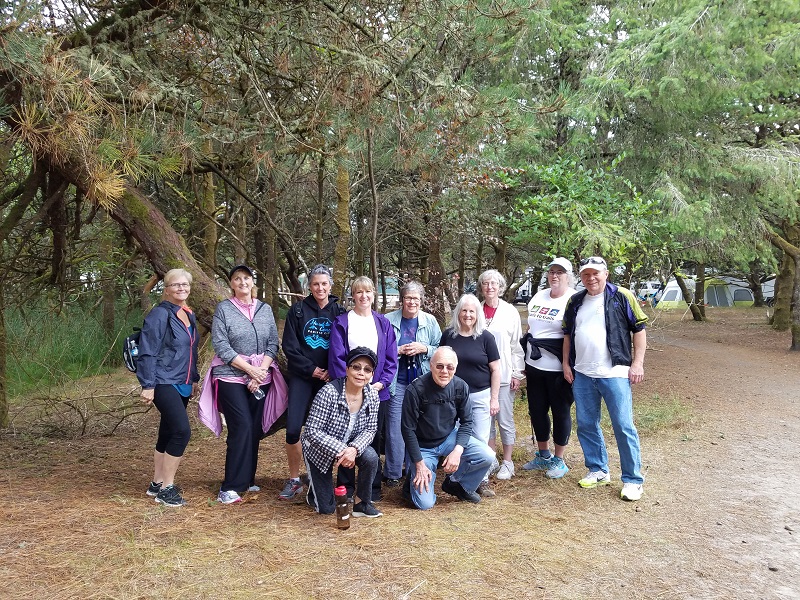
by Michelle | Apr 18, 2019 | Move Well
Tillamook County Wellness partners are helping families spring into summer with local running clubs, disc golf and other fun community programs and events. Here are some things for families to consider when planning ways to keep kids active and engaged as the school year comes to an end.
Research shows being active outdoors improves kids’ physical, social and emotional development and even their ability to learn. While free play, riding bikes, running and jumping are important for developing motor skills, these activities also help form the neural networks kids use for learning. “Basically, moving helps wire the brain,” says Michelle Jenck, local fitness and movement specialist.
According to Jenck, encouraging kids to be active in as many ways as possible, from the time they are born, is critical for brain development. Just like kids, babies need to have free time to move in unique ways. “Early reflexes have to be integrated for sensory processing and other key systems of the brain to develop properly,” states Jenck. “Babies need ‘tummy time’ on the floor and should be allowed to roll and crawl to support brain development. As children grow, movement continues to impact how well the brain processes information. When these systems are not working well, it can affect kids’ behavior, impulse control and emotional regulation, all traits that are foundational for developing health relationships and self-esteem,” Jenck continued.
The largest study on this topic came from the State of California. They compared state-wide physical fitness and academic scores of all children in 5th, 7th and 9th grades and found a consistent and significant correlation between the two areas. “In other words, the more active kids are, the better they perform in school,” states Jenck.
There are several local programs and events for families looking to help kids become more active. A new Ultimook Youth Track Club has formed. Kids 1st-8th grade meet Monday, Wednesday and Friday at 5:00 pm at Bud’s Fitness Trail located at Tillamook Junior High. Coaches will work with kids to develop aerobic training, teamwork, character and leadership skills. Participants will have the opportunity to register and compete as part of the Ultimook Youth Track Club at fun runs and track meets. For more information, visit ultimooktrackclub.oregoncoastalflowers.com.
Also at the Tillamook Junior High School, is the new Bohannon Disc Golf Course, which is fully accessible to the public at no charge. Disc golf is played like traditional golf but with discs, similar to frisbees, rather than balls and clubs. Participants will need to bring their own discs.
Mark your calendars for May 4th! The City of Tillamook is hosting the Waterfront Walk to celebrate the grand opening of the new paved path connecting Goodspeed Park with the Hoquarton Trail. Several community partners will be on hand with interactive games and activities, raffle prizes and more. The event begins at 11 am.
Then, from 1-3 pm on May 4th, families can participate in Healthy Kids Day at the YMCA, located at 610 Stillwell Avenue in Tillamook. Early Learning Hub partners are teaming up to offer fun, activity stations for kids of all ages. The event is free and open to the public.
The YMCA, NCRD and OSU Extension all offer a variety of youth programs and services over the spring and summer months. Call or visit their websites for more information. Follow Tillamook County Wellness on Facebook or visit our website tillamookcountyhealthmatters.org for more local wellness information and updates.

by Michelle | Apr 10, 2019 | Work Well
Truck Driver On the Road to Healthy Habits, Sees Results
For a truck driver, long hours behind the wheel make it important to be alert and healthy. And there are physical demands of the job, from tying down loads, tarping, the stress of driving, and even climbing in and out of the truck. For Ted Craig, age 48, the demands of hauling hay had begun to take their toll. Getting up and down off the trailers left him out of breath and with sore knees. Even though he was active, he was actually gaining weight and felt lousy.
To meet his CDL medical requirements, Ted was taking blood pressure medication and using a c-pap machine* to help him sleep at night. Frustrated that his health was negatively impacting both his job and his quality of life, he decided it was time to make some changes. He set several goals for himself – to lose weight, get off his blood pressure medication and unplug the c-pap machine.
The first change Ted made was to eliminate soda from his daily regimen. Not being a coffee drinker, Mountain Dew was his go-to drink on the road. “My job makes it hard because I am not home every day,” Ted said. “I was addicted to pop, drinking three to four 32 oz. sodas a day. Every store, every fast food restaurant, has soda on the road,” he continued. As with any major health behavior change, Ted shared that the first few weeks cutting out pop were very difficult.
Ted also noted how cost can be an issue. “Eating healthy can be more expensive,” he states, but he says, “What you put into your body, you get back out of it.” He went on to say that fast food restaurants are starting to accommodate people by offering healthier menu items and options. “You have to learn how to pick from the menu,” he added.
Ted and his wife are eating healthier meals at home as well, raising their own beef, eating more vegetables and cutting out sugars. To date, he has lost more than 50 pounds and his wife has lost about 45. They both feel better and have more energy. Their doctor is thrilled with their success and is sharing their story with her other patients.
Ted points out how important it is to have a goal. “It can’t just be about the weight. My dad was diabetic. I didn’t want to develop diabetes and go through the issues my dad faced. By the time he was 70, he had toes and even part of his leg amputated,” Ted added.
When asked what advice he would give to others, Ted highlights the permanence and gravity of the effort. “It’s a lifestyle you have to be willing to change. It’s something you work at every day, just like a marriage. You have to put in the time, to get the results.” Ted has already achieved two of his three goals, losing weight and getting off his blood pressure medication, and he has set his sight on getting off the c-pap machine next. As Ted’s transformation continues, he’s happy to share his journey with others, what’s worked for him and is encouraged to continue his progress, one day at a time.
For more tips and inspiration, visit our website Tillamookcountyhealthmatters.org or like and follow us on our Tillamook County Wellness Facebook page.
*A c-pap machine is recommended for people with sleep apnea.
What is Sleep Apnea?
According to the National Institute of Neurological Disorders and Stroke (NINDS), “sleep apnea is a common sleep disorder characterized by brief interruptions of breathing during sleep. These episodes usually last 10 seconds or more and occur repeatedly throughout the night. People with sleep apnea will partially awaken as they struggle to breathe, but in the morning, they will not be aware of the disturbances in their sleep.” Symptoms of the disorder include: excessive daytime sleepiness, restless sleep, loud snoring (with periods of silence followed by gasps), falling asleep during the day, morning headaches, trouble concentrating, irritability, forgetfulness, mood or behavior changes, anxiety, and depression. Not everyone who has these symptoms will have sleep apnea, but it is recommended that people who are experiencing even a few of these symptoms visit their doctor for evaluation. Sleep apnea is more likely to occur in men than women, and in people who are overweight or obese.

by Michelle | Apr 4, 2019 | Move Well
Step It Up! Tillamook County
April is “Move More” month and the first Wednesday in April is National Walking Day. To celebrate, we are teaming up to offer Step It Up! Wellness Walking Groups. Being active and having positive social support are keys to lifelong health. Research shows people are more successful in making lasting health behavior changes when they feel supported and find enjoyment in new activities. Joining a walking group is a great way to get healthy while having fun with friends, old & new.
Walking groups that formed last spring are welcoming new walkers in south, central and north Tillamook county. Groups are informal, volunteer-led and drop-ins are welcome. Comfortable shoes, layers and rain gear are recommended as groups walk outdoors, rain or shine. Groups walk approximately ½ hour, arrive a few minutes before the start time since groups begin walking immediately. Walking groups meet at the following locations/times:
South County – starts April 1
Kiawanda Community Center, Monday, Wednesday & Friday, 10 am. For more information contact Julie, 503-863-9307, Juliekrohn@gmail.com or Cathy, cathy@griffinnetwork.com
Central County – starts April 1
PRI Building/OSU Extension Office, Monday, Wednesday & Friday, 10 am. Contact Corinna, 503-801-0789, matsell83@charter.net for more information.
Tillamook Junior High, Saturday, 9 am. Contact David & Doris Mast, 503-801-2944 or 503-812-6789, davidmast48@gmail.com or dmast0526@gmail.com for more information.
North County – starts April 16
Neah-Kah-Nie High School Track, Tuesdays, 8 am. Contact Patty, 503-355-8040 or Lena, mamalinabest@gmail.com for more information.
If you can’t attend an existing walking group, you can form your own. Ask co-workers or other walking partners to join you and set a regular schedule for days and times you plan to walk. Lunch breaks are a great time to get in a quick 20 or 30-minute walk. Consider walking together as a family after evening meals. Whether you walk, hike or run, alone or with others, you’ll feel refreshed and energized being active outdoors.
Visit our website tillamookcountyhealthmatters.org and follow us on Facebook at “Tillamook County Wellness” for more health tips and information.

by Michelle | Mar 27, 2019 | Eat Well
Thanks to a sponsorship by Tillamook County Wellness partner, Oregon Dairy & Nutrition Council, we will periodically feature articles and recipes from Judy Barbe, author, columnist and nutrition expert. As a registered dietitian nutritionist and food enthusiast, Judy offers realistic food solutions to help people “live their best.” Judy was a featured speaker for the Tillamook County “Year of Wellness” in 2016.
Meal Planning 101: Scan, Plan & Cook
By Judy Barbe RDN, LiveBest
It’s 5 o’clock. Somewhere.
That means it’s time to kick back and relax. Right?
Somewhere. But not after work when the kids want attention and the dog demands even more. And you’re trying to get dinner on the table.
If you want to control chaos, save time and money, and reduce wasted food, meal planning is your ticket. Here are three steps to get you going.
- Scan
Before you grocery shop, scan your cupboards, fridge and freezer. Are there foods on hand you can use to start a recipe? Tomatoes (canned or fresh) can be simmered with olive oil and garlic to make a pasta sauce. If you have a can of olives, tuna or clams, add those. Do you have vegetables you can repurpose into a salad, soup, or salsa?
- Plan
Plan at least 3 meals you can make this week. Check the grocery promotions to see what’s on sale and what’s in season. Seasonal fresh fruit and vegetables taste best and cost less. Ask the store produce manager to learn what’s in season. Plain frozen and canned fruits and vegetables are also good options. Keep high-fiber foods in mind. Fiber is found in plant foods such as beans, seeds, nuts, whole grains, fruits and vegetables.
Think about how you can use what you’re cooking in another meal. Cooking ground beef or turkey? Cook extra and freeze for another meal. Baking salmon? Save some for a salad with lettuce, avocado, cucumber and orange slices. Cooking quinoa? Make extra to add to soups, chili, or toss with black beans, corn, mango, green chiles and a vinaigrette.
- Cook
Set aside a power hour for meal prep that will last all week.
- Set the oven to 350° F. to bake nuts, vegetables, or chicken. Potatoes can be reheated later and topped with broccoli and cheese or chili. Add chicken to salads or casseroles.
- While the oven is heating, chop vegetables for side dishes, snacks and lunches. Keep some raw and store them at eye level, in a clear container in the fridge. When they’re the first things you see, you’re more likely to eat them. Toss some with 1- 2 teaspoons of olive oil, spread on a baking sheet and bake until just tender. Add to tacos, pizza, salads, or a frittata.
- Simmer a pot of soup. Split pea soup, Peruvian Quinoa or white bean chicken chili can give you a night or two of meals.
- Hard cook eggs. Perfect for breakfast, lunches, and snacks. Add in salads, such as canned beets, toasted walnuts and blue cheese crumbles or curry egg salad.
- Cook a whole grain such as quinoa, bulgur, or wheat berries. This is an easy way to boost fiber and protein in salads or stuff a pepper. Yogurt and fruit are another way to enjoy whole grains.
- Blend bean dip or hummus for a high-fiber snack that’s ready when hunger strikes. Pack it with veggies and whole-grain crackers for lunch.
As you finish, pack foods in airtight containers, label and place them in the fridge or freezer. The more you plan, the easier the routine becomes. You’ll also appreciate when the 5 o’clock rush is more like “I’ve got this!”
Registered dietitian Judy Barbe specializes in realistic food solutions. She is author of Your 6-Week Guide to LiveBest: Simple Solutions for Fresh Food & Well-Being. Visit her website www.LiveBest.info.

by Michelle | Mar 27, 2019 | Lunch & Snack Recipes, Recipes
Overnight Oats
Recipe and photo source: LiveBest, Judy Barbe, RDN
Because this is a make-ahead recipe, overnight oats make it easier to rise and shine by taking some stress out of the morning rush. That benefit continues because they keep up to 4 days in the refrigerator.
Here’s how you make overnight oats while you sleep
- Layer food in Mason jar.
- Place in fridge.
- Wake up.
- Grab spoon.
More specifically, start with grains on the bottom so the milk and yogurt soften the grain. Mix and match from each section based on preference. To keep portions in check, I use a pint-size jar and half-pints for kids.
- 1/3 cup raw whole grains: rolled oats, bulgur, steel-cut oats.
- Pinch to 1/4 teaspoon spice: ginger, turmeric, cinnamon, cardamom, vanilla, pepper.
- 1-2 tablespoons nuts or seeds: quinoa, almond butter, peanut butter, hemp seeds, flax meal, walnuts, sunflower seeds, pumpkin seeds.
- 1/3 cup yogurt. Mix plain with flavored to keep sugar levels reasonable. If you don’t want yogurt, replace with more milk.
- 1/3 cup milk.
- 1-3 teaspoons flavor: honey, cocoa powder, instant coffee, maple syrup, jam, apple butter, orange juice, chai, crystallized ginger, coconut, orange zest.
- 1/2 -1 cup fruit: strawberries, mango, peaches, blueberries, bananas, pumpkin, cranberries, or cherries (fresh, frozen canned, dried, they all work). Vegetable ideas are shredded carrots or chopped spinach.
- Save crunchy toppings for last minute toppers. Crumbled graham crackers, granola or toasted nuts or coconut.
Registered dietitian Judy Barbe specializes in realistic food solutions. She is author of Your 6-Week Guide to LiveBest: Simple Solutions for Fresh Food & Well-Being. Visit her website www.LiveBest.info.





